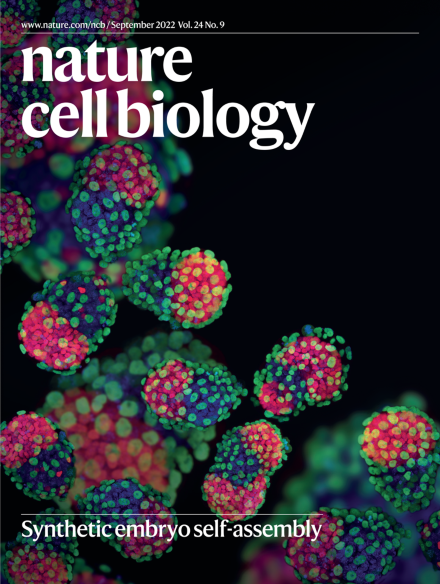机械渗透信号控制多能干细胞的染色质状态和命运转变。
IF 19.1
1区 生物学
Q1 CELL BIOLOGY
引用次数: 0
摘要
获得特定的细胞形状和形态是细胞命运转变的核心组成部分。虽然调控多能干细胞分化的信号通路和基因调控网络已经得到了深入的研究,但这些网络如何在空间和时间上与形态变化和机械变形相结合以控制状态转变仍然是一个基本的开放性问题。在这里,我们将重点放在两种不同的多能性模型上,即人类胚胎着床前的内细胞群细胞和引物多能干细胞,以发现细胞命运的转变与核形状和体积的快速、压实触发的变化有关。这些表型变化和相关的核膜主动变形是由生长因子信号控制的细胞骨架约束和染色质力学的变化引起的。由此产生的渗透胁迫状态触发了全局转录抑制、大分子拥挤和核凝聚物的重塑,这些凝聚物通过减弱分化基因的抑制来为细胞命运转变提供染色质。然而,虽然这种机械渗透染色质启动有可能加速命运转变和分化,但持续的生化信号是特定谱系的强大诱导所必需的。我们的发现揭示了一个关键的机械化学反馈机制,该机制将核力学、形状和体积与生化信号和染色质状态相结合,以控制细胞命运转变动力学。本文章由计算机程序翻译,如有差异,请以英文原文为准。

Mechano-osmotic signals control chromatin state and fate transitions in pluripotent stem cells
Acquisition of specific cell shapes and morphologies is a central component of cell fate transitions. Although signalling circuits and gene regulatory networks that regulate pluripotent stem cell differentiation have been intensely studied, how these networks are integrated in space and time with morphological changes and mechanical deformations to control state transitions remains a fundamental open question. Here we focus on two distinct models of pluripotency, preimplantation inner cell mass cells of human embryos and primed pluripotent stem cells, to discover that cell fate transitions associate with rapid, compaction-triggered changes in nuclear shape and volume. These phenotypical changes and the associated active deformation of the nuclear envelope arise from growth factor signalling-controlled changes in cytoskeletal confinement and chromatin mechanics. The resulting osmotic stress state triggers global transcriptional repression, macromolecular crowding and remodelling of nuclear condensates that prime chromatin for a cell fate transition by attenuating repression of differentiation genes. However, while this mechano-osmotic chromatin priming has the potential to accelerate fate transitions and differentiation, sustained biochemical signals are required for robust induction of specific lineages. Our findings uncover a critical mechanochemical feedback mechanism that integrates nuclear mechanics, shape and volume with biochemical signalling and chromatin state to control cell fate transition dynamics. McCreery, Stubb et al. show that mechano-osmotic changes in the nucleus induce general transcriptional repression and prime chromatin for cell fate transitions by relieving repression of specific differentiation genes.
求助全文
通过发布文献求助,成功后即可免费获取论文全文。
去求助
来源期刊

Nature Cell Biology
生物-细胞生物学
CiteScore
28.40
自引率
0.90%
发文量
219
审稿时长
3 months
期刊介绍:
Nature Cell Biology, a prestigious journal, upholds a commitment to publishing papers of the highest quality across all areas of cell biology, with a particular focus on elucidating mechanisms underlying fundamental cell biological processes. The journal's broad scope encompasses various areas of interest, including but not limited to:
-Autophagy
-Cancer biology
-Cell adhesion and migration
-Cell cycle and growth
-Cell death
-Chromatin and epigenetics
-Cytoskeletal dynamics
-Developmental biology
-DNA replication and repair
-Mechanisms of human disease
-Mechanobiology
-Membrane traffic and dynamics
-Metabolism
-Nuclear organization and dynamics
-Organelle biology
-Proteolysis and quality control
-RNA biology
-Signal transduction
-Stem cell biology
 求助内容:
求助内容: 应助结果提醒方式:
应助结果提醒方式:


